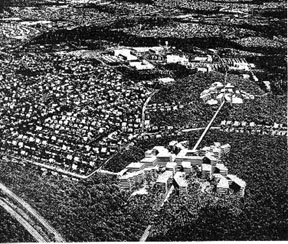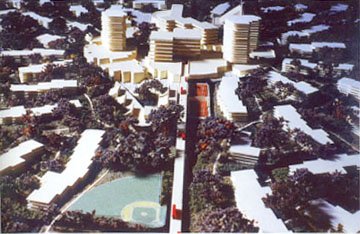THE URBAN OASIS: Guideways and Greenways in the
Human Environment
by Roxanne Warren, Architect
Author's Abstract of the Book
 The great majority of all kinds of trips begin or end at
home; and when an automobile is needed on either end of a
trip, there is every incentive to continue by car for the
entire journey. Thus, it seems fairly certain that providing
high quality systems of local circulation in close proximity
to development with a residential base will make the use of
longer distance public transport far more convenient,
feasible, and likely.
The great majority of all kinds of trips begin or end at
home; and when an automobile is needed on either end of a
trip, there is every incentive to continue by car for the
entire journey. Thus, it seems fairly certain that providing
high quality systems of local circulation in close proximity
to development with a residential base will make the use of
longer distance public transport far more convenient,
feasible, and likely.
Providing a quality of local service capable of
competing with the private car requires 24-hour availability
and reliability - criteria uniquely satisfied by
automated peoplemovers (APMs). Yet ironically, when
densities of development rise sufficiently high to justify
installation of guided transit, they are typically associated
with traffic congestion and the massive paving of land for
roads and parking - factors which have helped to spur
centrifugal migration toward outlying areas and away
from access to public transport. With this dispersal of
population, the cities are deprived of wealth and culture;
non-motorists, including children and the elderly, are
isolated; and per capita consumption of land and fuel spirals
upward to unprecedented proportions.
We have the means at hand to make centripetal migration
once again desirable, through a synthesis of four key
elements: 1) new urban neighborhoods as pedestrian
zones 2) peripheral parking, 3) abundant
re-landscaping, and, tying it all together, 4)
short-range automated shuttles and loops (which just
happen to be the most economical types of APM to build and
operate). In conventional high-density construction, its
associated parking is contained on sub-plaza levels; all
levels above the plaza comprise, in effect, a pedestrian
zone. But with an automated shuttle or loop serving as
"horizontal elevator", this organization can be
turned on its side, with its parking structures located at
nearby highways and major roads, and its buildings suffused
with living vegetation. Lest peripheral parking be considered
onerous, the APM should be fare-free, with its costs covered
through rentals and parking fees; this will also preclude the
need for fareboxes, and make the system more user-friendly
and less costly to build and operate.
Several variations on this scheme are illustrated; each
would house a community of some 5000 residents, together with
commercial, educational, and community amenities. In one
example, new development is clustered in compact form within
a 3-minute walk of its station, and ample amounts of
surrounding greenspace are protected from being taxed into
development through a binding easement. In another, a
station-cluster is built at lower densities for the same size
population, with the length of station access extended to a
maximum 5-minute walk; here the development is more
continuously pervaded with semi-private areas of greenery. In
a third type, the available land consists of smaller tracts,
with new development distributed among two or more
station-clusters - an option where larger tracts of land are
unavailable. A fourth type would include and count residents
of existing adjacent buildings as part of the community of
5000 - a scheme for which new clusters may, in fact, be more
easily retrofitted within existing urban areas.
 In this model of an urban oasis, buildings are clustered
within a 5-minute walk of the station of an automated
guideway circulation system. Immediately around the station
are a sizable regional shopping mall and low-rise office
facilities, aimed at attracting the public from a wider area,
as well as residential towers containing small apartments.
Densities trail off toward the greener outskirts, decreasing
down to two-story matrix housing at the fringes.
In this model of an urban oasis, buildings are clustered
within a 5-minute walk of the station of an automated
guideway circulation system. Immediately around the station
are a sizable regional shopping mall and low-rise office
facilities, aimed at attracting the public from a wider area,
as well as residential towers containing small apartments.
Densities trail off toward the greener outskirts, decreasing
down to two-story matrix housing at the fringes.
Located within or near a city, strategically sited
within reach of a major transportation corridor, yet built in
a green park, the urban oasis would juxtapose advantages of
urban and rural space. It would reintroduce into the larger
urban area, through a highly contemporary expression of
guideways and greenways, those desirable components of the
small town - an intimate scale among neighbors and a close
proximity to nature - which have been all but lost in our
explosion of development all over the landscape.
The book contains an overview and analysis of pedestrian
zones in Europe and North America, and of elements that have
contributed to their successes or failures. Also included are
illuminating descriptions of the numerous types of automated
peoplemover technologies, in language that is accessible to
the lay reader. It is concisely written in 197 pages, and
includes 98 illustrations.
Roxanne Warren, AIA, is principal of Roxanne Warren
& Associates (NYC), whose major clients have included the
NYC Transit Authority and the Port Authority of NY & NJ.
She was formerly with I.M. Pei, among other firms, has spent
many years in the study of automated guideway transit
technologies and their potential urban application, and has
been an active participant in conference seminars on the
subject in the United States and France. She is a member of
the Transportation Research Board and serves as a member of
the Board of the Advanced Transit Association
Roxanne Warren can be reached by phone at 212-580-5500
(office) or fax: 212-580-5690 or via e-mail:
rwaa@erols.com Her mailing address is Roxanne Warren
and Associates, Architects, 2112 Broadway - Suite 507, NYC
10023
Copies of the book can be ordered from McGraw-Hill,
phone 1-800-2mcgraw or www.amazon.com. The Amazon price is $51.73 new, $0.48
used.

Last Modified:
06/08/2013
The great majority of all kinds of trips begin or end at home; and when an automobile is needed on either end of a trip, there is every incentive to continue by car for the entire journey. Thus, it seems fairly certain that providing high quality systems of local circulation in close proximity to development with a residential base will make the use of longer distance public transport far more convenient, feasible, and likely.
In this model of an urban oasis, buildings are clustered within a 5-minute walk of the station of an automated guideway circulation system. Immediately around the station are a sizable regional shopping mall and low-rise office facilities, aimed at attracting the public from a wider area, as well as residential towers containing small apartments. Densities trail off toward the greener outskirts, decreasing down to two-story matrix housing at the fringes.